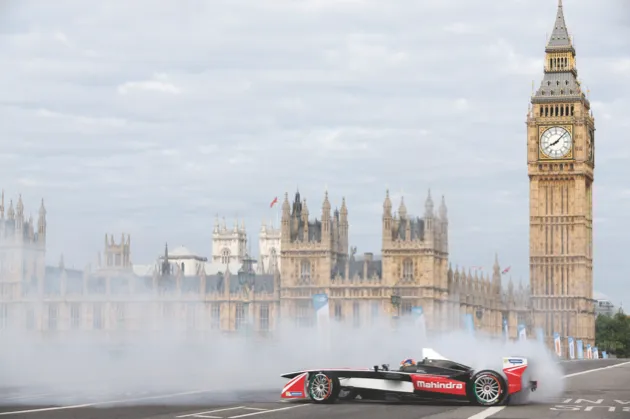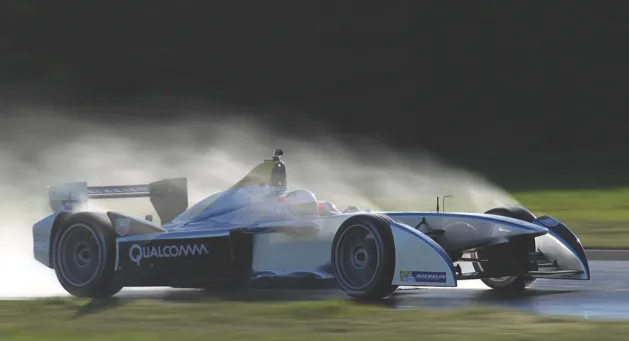July began like most months at the Donington racetrack, with high-performance cars being put through their paces on the Leicestershire circuit. But there was one difference: instead of echoing to the familiar cacophony of high powered combustion engines, the air around the circuit was quiet and calm.
The peace was only interrupted when one of the sleek, new racers being tested came rushing by, whooshing like some kind of futuristic fighter jet. The cars were making a new and unusual noise: a noise that caught your attention but sounded nothing like the typical roar of a racing car. And that’s because the cars were not typical racing cars. They were Formula E racers.

Electric motors
Formula E is a new racing championship for single-seater cars that are powered solely by electricity. It’s a novel twist, but with so many existing classes of motor racing – from Formula 1 and Touring Cars to GT Endurance and NASCAR – do we really need another?
Alejandro Agag, the CEO of Formula E Holdings, would argue yes. The Spanish businessman says there are two reasons why we need Formula E. “The first is to make electric cars more popular – to show them racing and use the sport to get people interested in them. The second is to use the races as a platform for research and development to improve electric powertrains, batteries and charging systems.”
And we need to develop this technology because the pollution caused by combustion engines in congested cites, and dwindling oil reserves, mean there’s a need for cleaner, more energy-efficient and sustainable transport options. Agag believes electric vehicles are one way to meet that need.
But electric cars are not without problems; problems that may put some people off – the biggest one being their range. And it’s a problem that will need to be solved quickly because, right now, a Formula E car’s battery doesn’t have enough energy to get it through a race.
Battery power
For the first year of the Formula E championship, all the cars are running stock equipment, so they all have the same battery built by Williams, the company behind the Formula 1 team. It’s a lithium-ion unit based on the one Williams made for the Jaguar C-X75 hybrid supercar.
It's similar to the battery you’d find in a laptop or mobile phone, but has a lot more cells and a slightly different chemistry. “Within lithium-ion batteries there are different chemistries and each of them is better suited to different applications, so you have to select the right one,” explains Okan Tur, chief technical specialist for hybrid systems at Williams.
“There are better chemistries for power, better chemistries for energy and there are better chemistries for applications that lie in between those two. We’ve selected one of those but, to keep our competitive edge, we’re not declaring which chemistry we’re using at the moment,” says Tur.

But while the Jaguar C-X75 can use its petrol engine to reduce the drain on the battery and increase the car’s range, the Formula E cars don’t have that luxury. So, for the first season, to make it to the chequered flag, the drivers will have to come into the pits during the race and jump into a second, fully charged car.
Pit strategy will therefore shape the racing, but the winner will be the driver that can best manage the battery life during each car’s stint on the track. And the cars have been designed to extend the life of the batteries as long as possible. “We don’t have enough energy in the batteries for a long race with the Formula E car,” says Christophe Chapelain, Technology Manager for Renault Motorsport, who oversaw the construction of the cars. “So we must optimise the use of the energy and to do that we had to decrease the car’s [aerodynamic] drag as much as possible. This is why the car is the shape it is. We have structures in front of the wheels to reduce drag and have done everything we can to make the car more efficient.”
Tyred and tested
And that includes taking a whole new approach to the tyres. “This is the first time that a single-seater championship will use 18-inch [45.7cm] tyres,” says Serge Grisin, Technical Director for endurance racing tyres at Michelin, the tyre supplier for the Formula E Championship.
“The wider diameter and smaller sidewall reduces the tyre’s rolling resistance. We chose 18-inch tyres because it’s very close to the size you find on a lot of road cars. That means the link and the technology transfer between Formula E and road cars is obvious. Other championships [such as F1] use 13-inch [35.5cm] tyres with big sidewalls, which isn’t relevant to road cars,” says Grisin.
The tyres also can’t be changed. Unlike in F1, where each car has 13 sets of tyres to choose from per race, each Formula E car is only allowed one set for each round of the championship. So the rubber a Formula E car rides on has to last through practice, qualifying and the race, meaning the tyres have to be durable and efficient, but they also have to be able to perform in both wet and dry conditions. It’s a combination that caused a lot of head scratching at Michelin when it came to choosing the rubber compound, tyre construction and tread pattern.

The result is the Pilot Sport EV, a tyre that draws on the experience Michelin has gained in endurance racing. But it also shares some traits with the Energy EV, a road tyre developed specifically for the Renault Zoe that increased the small electric car’s range by six per cent.
The aerodynamics, the tyres and everything else about the car have been designed to prolong the life of the battery, but sooner or later it still needs to be recharged. For now that means plugging the cars into a recharger, but that’s set to change.
“Wireless recharging technology is being developed by Qualcomm, one of Formula E’s partners,” says Agag. “[Rather than having to be plugged in], the car parks on a pad that recharges it by induction. The beauty of a wireless system is that it gives us two charging options: static and dynamic. For static wireless charging the cars have to park on a charging pad… but with dynamic charging the cars could recharge as they’re racing.”
Dynamic wireless charging technology already exists and is used to recharge robots as they move around factory floors performing tasks. “The [same] technology could work in cities,” suggests Agag. “You could place the static charging pads in car parks, but even if you put them at traffic lights, your car would get a small amount of charge when you stopped at a red light. And if you were to incorporate the dynamic charging technology into the roads you could keep your car going forever.”
Street racing
The technology Formula E is being used to develop will take a few years to reach the streets, but the cars will be there from the start, because the championship will be contested on city centre circuits. And, as Peter van Mannen of McLaren, the makers of the Formula E motor, explains, part of the reason for that is the way electric motors perform. “The thing about an electric motor is that it provides torque instantly – as soon as you turn it on you create torque and as soon as you turn it off you create braking,” he says. “So electric motors are most interesting, and potentially the most fun, on courses that involve a lot of stopping and starting, which is a characteristic of city circuits.”
So the cars being fine-tuned around the Donington racetrack in July are ultimately bound for street circuits in cities such as Beijing, Buenos Aires, Long Beach and London. The first race, which took place in China on 13 September, saw the cars racing past the Bird’s Nest stadium used for the 2008 Olympics. Next, the championship will travel around the world to showcase and improve on the current state of electric car technology.
The teams and drivers will look to make improvements to win races, but the aim of the championship is for those improvements to lead to energy-efficient road cars. At its heart, Formula E is a laboratory for developing advanced vehicles and cleaner, more sustainable methods of keeping them going. If it manages to do that, it could be one of the most important laboratories in the world.
Robert Banino is a science writer and editor.
This article first appeared in the September 2014 issue of BBC Focus Magazine